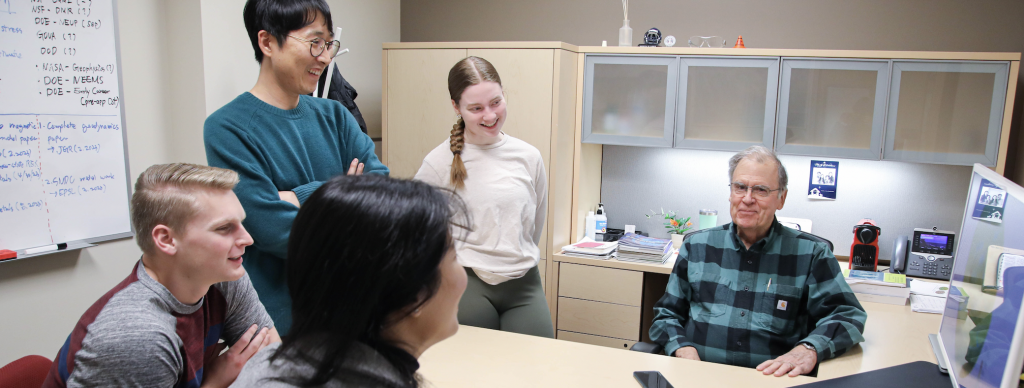Some people take for “granite” the scientific knowledge available to man today. But such knowledge is only uncovered by persistent scientists who continually learn and discover.
For over 40 years now, Dr. John Baumgardner, a research professor in Liberty’s School of Engineering, has been investigating processes of the Earth as they relate to the Genesis Flood. He and Dr. Heechen Cho, assistant professor of mechanical engineering, study geology with the goal of showing that the Flood is a genuine and prominent part of the earth’s past.
In their current research, Cho and Baumgardner work to simulate the Genesis flood. They utilize complex computational codes to model what occurs inside the Earth that allows the rock to deform rapidly.
One such code is TERRA, which Baumgardner designed while getting his Ph.D. at the University of California, Los Angeles. Cho has helped further develop the code. Now, scientists all over the world use the code to simulate how rock flows inside the Earth’s mantle.
Baumgardner and Cho’s conclusions for the cause of the Genesis Flood is catastrophic plate tectonics. They find that tectonic plates can move at speeds of a few miles per hour instead of a few inches per year because rock in the mantle weakens under increased stress.
They conclude that such weakening occurred during the Flood, leading to the rapid recycling of the pre-Flood ocean floor into the mantle and the formation of new ocean crust. Since this new crust was warm and of lower density, it caused the sea bottom to rise. With the swelling sea bottom, the ocean had no choice but to spill over and flood the land, as described in Genesis. This is part of what scientists like Cho and Baumgardner conclude happened just a few thousands of years ago during the familiar story of Noah’s flood.

Cho’s research focuses on studying the mechanisms that could cause the weakening of the Earth’s mantle at an atomic level. His research concentrates on the minerals olivine and pyroxene, two of the most prominent minerals in the mantle.
“We try to better understand what’s going on in the material at the atomic level when a force is applied,” Cho said.
The two geologists have many other reasons for concluding that the Flood really happened. They cite the immense horizontal scale of the rock layers in the Grand Canyon and elsewhere, as well as the lack of erosion on the boundaries between these layers, as evidence for global scale processes not occurring today. The only way these layers could have formed was if water rapidly flowed over and covered the entire globe, which corroborates the account of Genesis.
“The Earth’s fossil-bearing sediment layers … testify clearly to global cataclysm beyond what the human mind can possibly imagine,” Baumgardner said.
Another piece of evidence that Baumgardner and Cho take to support the Flood’s reality is seismic images of the mantle that show large blobs of cold rock at the base of the mantle. This cold rock is approximately the same temperature as rock near the surface, nearly 3,000 degrees Celsius cooler than the rock surrounding the blobs.
According to the researchers, the temperature difference fails to be explained with secular theories. If, as they believe, the cool rock has been sinking for millions of years, it would have heated up by now. But catastrophic plate tectonics implies that these tectonic plates have subducted — slid underground — much more rapidly and recently, explaining the cooler temperatures.
“This has been a major dilemma for secular earth scientists for 30 years,” Baumgardner said. “We have answers where they don’t.”
Cho and Baumgardner continue their research at Liberty by utilizing the school’s computers and facilities to refine the codes and model these processes inside the Earth. Students passionate about Young Earth Creationism theory join them in their endeavors.

Emilie Hatton, a senior mechanical engineering major, is simulating the theory of steam jets for her honors thesis. These steam jets occurred when hot magma on the ocean bottom contacts the cool ocean water, nearly instantly converting it to steam that shoots through the ocean and into the atmosphere. Eventually this water came back down as rain, potentially corresponding to the 40 days of rain described in Genesis.
“The most important thing I have learned through all this is truly how intricate God’s design is,” Hatton said. “Trying to model something that occurs naturally in creation really points out how complex each element is.”
Maria Lee, a second-year graduate student studying material science engineering, works with Cho on their research regarding how stress affects a mineral’s atomic structure. She became involved in the research after meeting Cho at her church and hearing him speak about creationism.
Lee and Cho use the computer program MOOSE to simulate the physical properties of olivine and pyroxene under stress. Their research involves a lot of trial and error. After making adjustments in their model, they run a programmed simulation which may take only half an hour or up to eight hours to run.
“I learned how God’s (creations) are just beyond human knowledge and imagination,” Lee said. “We can only try to understand to some extent, but we can’t ever understand 100%.”
Even when facing opposition from their secular contemporaries, Baumgardner and Cho persevere in their research. They are some of the only geologists in the world actively working to model and understand the Genesis Flood cataclysm. Their research is nevertheless acknowledged by their secular peers and furthers the knowledge of geology.
“We need to be courageous,” Cho said, acknowledging that most geoscientists do not accept their worldview and convictions concerning earth history.
To read more about their research, visit their website.
Bear is the feature editor for the Liberty Champion

